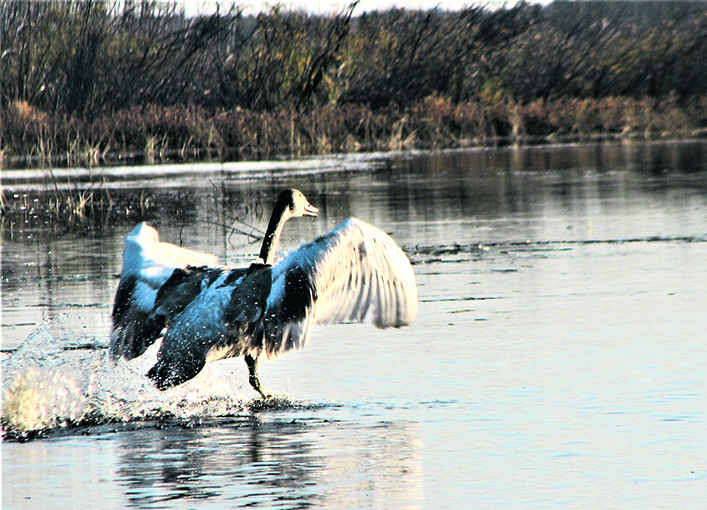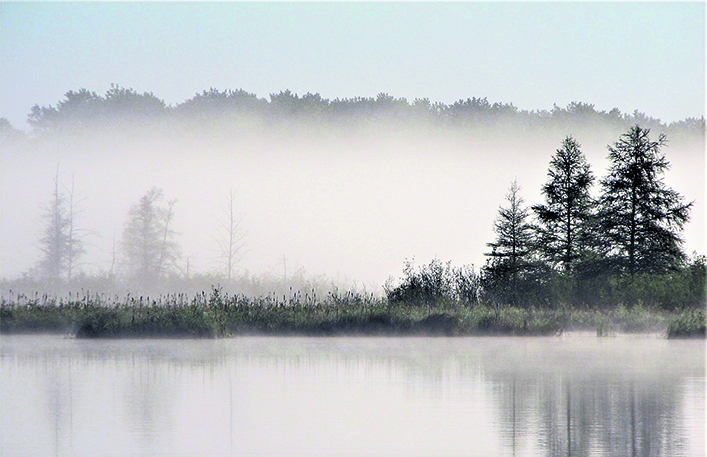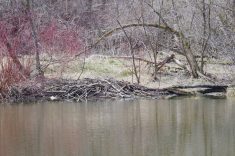Glacier FarmMedia – Back in 2007, I was fishing at my favourite wild rice lake in the Whiteshell when I spotted some big, white birds in the distance. I didn’t think much of it at first; I assumed they were pelicans.
As I got closer, it became obvious that the size and shape were wrong. I got out the binoculars and, sure enough, they weren’t pelicans. I was looking at my first trumpeter swans.
It was an epic sighting. The species had just started to appear in southeastern Manitoba after an absence of more than a century.
Trumpeters are among the most majestic wild creatures in these parts, and we can enjoy them now because of an outcry for conservation and years of recovery work.
With a wingspan up to three metres and a body length up to two metres, bill to tail — taller than most people — trumpeters are big birds any way you measure them. They are also among the heaviest birds on the planet still capable of flight.
Their distinguishing features include a very long neck, totally white plumage and the unique vocalization that gives them their name.
It’s hard to visually separate them from their smaller, more abundant cousins, the tundra swan, although the latter only uses southern Manitoba as a stopover while migrating to the subarctic, where they nest. Tundra swans are absent in the summer. If you’re seeing clusters of swans in south or central Manitoba from June to September, they’re likely trumpeters.
The higher pitched, honking call of a tundra swan is quieter and more delicate than the trumpeter’s blare. The trumpeter swan’s call is distinct; when you hear it, you’ll know. The bugle is amplified by their extra-long windpipe, which dips well into their body cavity.
I asked my colleague, Michael Anderson (an emeritus scientist at Ducks Unlimited Canada and board member of the Trumpeter Swan Society), if he could precisely describe the call. He was a bit stumped, but eventually landed on the following: “The call is haunting. It’s dramatic, large and deep. It speaks of wilderness and wild things.”
The species historically nested in the northern Prairies and the Parkland and boreal regions of Central and Western Canada and Alaska. They prefer shallow lakes and deeper wetlands, especially areas with boggy fringes and a good supply of emergent and submergent plants.
Breeding pairs come early in spring to claim territory and build a nest, often on an old beaver or muskrat lodge. Five to seven eggs are laid, and the young hatch ready to swim and feed under the watchful eye of both parents.

Their food in the first few weeks consists of protein-rich invertebrates, after which they switch to the vegetation diet of their parents. At 14 weeks, they will eat an astonishing 20 pounds of marsh tubers, roots and shoots a day, getting their bodies ready for migration.
It’s not unusual for trumpeters to stay in their nesting regions until they are pushed out by ice. I was ice fishing close to the Winnipeg River in mid-December last year when I was startled by a fly-by of adults and yearlings. I was standing on ice 20 centimetres thick at the time, but there was still open water on the main river. I guess that was good enough for them.
The earliest written record of trumpeters suggests they were widespread, but not abundant, which makes sense for a bird that defends large breeding territories. One modern-day researcher estimated that the population may once have been close to one million birds.
As the fur trade took hold and European settlement followed, the unfortunate trumpeters were marked for their cash and food value. There was vigorous trade in swan skins, from which the finest ink quills and the most sought-after powder puffs and dress highlights were made.
Ironically, famed bird painter John James Audubon preferred swan quills when he drew the legs of birds.
Populations dwindled in populated areas, where the big and easily seen birds fell to the fowling pieces of market hunters and hungry settlers alike.
Like other species of the time, relentless harvest eventually took a staggering toll. A continental count in 1935 was frightening: it found only 69 birds, all in remote areas around Yellowstone National Park. There were no birds left in the east.
Full protection status and new refuges in known breeding areas helped. Slowly, trumpeters mounted a comeback, and populations eventually reached a point where reintroducing the birds to former habitats could be considered. Announcements of previously unknown swan populations in northern British Columbia and Alaska in the 1950s and 1960s also offered new hope and a major source of eggs for recovery efforts.
The best way to introduce swans into a new area is to start with young birds. Things usually begin with removing one or two eggs from wild nests, though the pair is always left with some to raise. The birds are then reared in captivity and released into new areas, usually in the second summer.
Recovery projects were carried out in western North America, including some locations in Alberta and Saskatchewan. A little later, efforts hit full stride in the U.S. Midwest.
The results were more successful than even many conservationists could have hoped. The last continent-wide survey in 2015 came up with an estimate of 71,000 birds, and populations in many areas keep growing.
The hallmarks of trumpeter swan recovery are dedication and patience. Having your own advocacy group hasn’t hurt either. The Trumpeter Swan Society, established in 1968 and with members from across the continent (www.trumpeterswansociety.org), continues to be a voice for conservation, restoration and research.
Albert Hochbaum, a Manitoba-based waterfowl scientist, author, artist and first scientific director of the Delta Waterfowl and Wetlands Research Station, is credited as inspiring the society’s founding.
These days, I look forward to seeing trumpeters every spring when I fish the marshy backwaters off the Winnipeg River. Quite often, a pair or small group will fly by, loudly proclaiming their passage. The calls can travel well over a mile.
Come fall, I now count on seeing swans in my favourite Whiteshell duck hunting spot. Last autumn, I saw one impressive flock numbering around 50 birds.
One of my best trumpeter experiences was an encounter with a family group in 2010. It was early October when I spotted two adults and three young birds, which I knew had been hatched in the spring, since they couldn’t quite fly yet.
I thought I had spotted the first contemporary breeding record for eastern Manitoba until my colleague, bird conservationist Christian Artuso, gleefully reported a brood near Bissett from the year before. Oh well, second place isn’t bad.
The first Manitoba observations of swan resurgence were in the Duck and Porcupine mountains. The first nesting record came from Riding Mountain National Park in the 1990s.
These days, that western population is slowly expanding east and south. My brother lives on the south side of Riding Mountain National Park and started seeing trumpeters a few years ago. Anderson has spotted trumpeters around Minnedosa in the spring.
Hopefully these western birds keep expanding into the southwest, where trumpeters historically bred.
The birds we see in eastern Manitoba come from a U.S. Midwest population, the result of the release programs started in the 1960s. The 2015 continental survey found this group had grown to 27,000 birds and experts think it may have doubled since then.
That’s not bad for a region that had no swans a century ago.
As swan habitats fill up further south, we see the results up here. Birds not old enough to breed, wandering teenagers, so to speak, often spread to new areas. By the time they mature, usually at age four, they are already paired up and may breed in these new locations.
The remarkable pace of expansion means that trumpeters are now being spotted a long way up the east side of the province and west into parts of the Interlake. Some notable new breeding areas include Oak Hammock Marsh and marshes at Riverton and Hecla Island. The authoritative Birds of Manitoba, printed in 2004, spoke hopefully about “the possibility of the species once again becoming a member of our breeding avifauna.”
Today, the swans are way ahead of schedule.

As numbers increase, swans are popping up in places that have taken me by surprise. I now expect to see a few birds on ponds in the forested areas along the eastern stretches of the Trans-Canada Highway. Last spring, I watched a pair that spent about three weeks in a flooded farm field near Beausejour.
Big Creek, just east of the north entrance to Whiteshell Provincial Park, has started to hold birds in the spring and fall.
I didn’t have to get out of my car to take in any of these encounters.
When I asked Anderson about the main threats to trumpeters, strikes with power lines were the first thing he mentioned. Swans often fly at power line heights and, unfortunately, birds this big maneuver about as well as a jumbo jet.
Another concern is lead poisoning. Smaller lead weights used for fishing may get ingested, especially at swan wintering areas that are also popular fishing spots.
Lead shot was banned for waterfowl hunting about three decades ago, but residual pellets still lie in the feeding range of swans. As they dig deep into the marsh muck to pull up roots, old lead pellets may come along for the ride.
Sadly, as few as three pellets can be fatal, even to a bird this big.
The above threats notwithstanding, there is reason to hope that trumpeter swans in Manitoba will remain on a strong growth track for some time yet.
Tim Sopuck is former head of the Manitoba Habitat Conservancy, formerly known as the Manitoba Habitat Heritage Corporation. He can be reached at sopuck1304@gmail.com.















